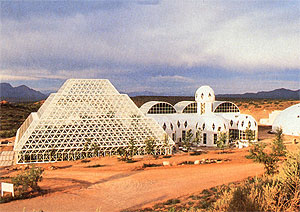Biosphere 2 Uses Miles of Copper Tube and Wire
 Biosphere 2 complex in Oracle, Arizona, where copper plays important role.
Biosphere 2 complex in Oracle, Arizona, where copper plays important role. Photo courtecy of Biospheres
More than 90 miles of copper wiring and five miles of copper plumbing tube are basic to the systems which provide the self-sustaining environment of Biosphere 2, a 5-million square foot glass-enclosure covering more than 3 acres of desert near Tucson, Arizona.
The $100-million-plus Biosphere 2 project is designed to totally isolate and independently sustain human, animal and plant life to prove the potential of establishing permanent research stations and settlements in space or on other planets, according to John Wesley Miller of John Wesley Consulting and Contracting. Biosphere 1 is the earth, he explains.
Because the project must meet all the physical needs of eight human beings inside for two years, "quality decisions had to be made," Miller said. "And copper was the quality choice. Copper is one of the key metals contributing to the self- sufficiency of Biosphere 2."
Miller and his company were responsible for the electrical, heating, cooling, ventilating and plumbing systems in the airtight, 85-foot-tall building and its six auxiliary structures. Miller worked with Gamble Electric and Sun Plumbing, both of Tucson.
Copper tube was used in Biosphere 2's major solar energy systems and in ten smaller solar energy hot water systems used in the auxiliary buildings.
"One of those buildings, the Tissue Culture Laboratory, is heated by a copper-tubed under-slab radiant heating system using solar energy," Miller said. "There's a quarter mile of copper tube just in that heating system alone."
The Biospheric Research and Development Center also includes a 17,000 cubic foot Biosphere 2 test module, a plant and aquaculture greenhouse, an insectary for propagation of insect species, quarantine and cultivation green-houses and other support buildings.
Miller spent more than six years working on Biosphere 2, where the doors were closed September 26th on the team of four male and four female scientists who will spend the next two years in isolated research with some 3,800 species of plants and a variety of animals.According to Miller, the basic design and engineering of Biosphere 2 was completed in 1986, with construction beginning in January 1987. Partial testing began last Fall. Full testing began this year.
Biosphere 2 is privately financed, Miller says, because it is so bold and expensive that no government or scientific center would be likely to pioneer one.
Space Biospheres Ventures, located on a 2,500-acre ranch near Tucson, has begun to market biospheric systems to potential clients, including space programs, universities, research institutes and governmental agencies.
Spin-off technologies from Biosphere 2 - relating to environ- mental monitoring and recycling systems, natural resource management and horticulture - have already emerged from the project.
Miller, who also heads up the Arizona State Solar Energy Commission, reports that the state is looking forward to a strong solar renaissance - with copper as a key material.
He identifies three of Arizona's solar projects: an 800-acre Solar Village in Tucson; a half-block area called Solar Oasis in Phoenix; and, a major photovoltaic installation on the site of Solar Village.
Both Solar Village and Solar Oasis will use copper solar collectors to power the domestic hot water systems on individual homes in these developments.
Also in this Issue:
- Biosphere 2 Uses Miles of Copper Tube and Wire
- High-Tech Copper Electrodes Help Cadillac Win Award
- Home of Future - Aglow with Copper and Brass
- Rigidized Metals Corp. Grows with Textured Copper Metals
- Copper Roofing Study Completed
- CDA Offers New Software for Bronze Bearing, Bushing Design
- DecoShield for Fire Sprinklers
- Copper Sculpture Baffles CIA
- Copper Consumer Products Draw Attention, Grow in Sales
